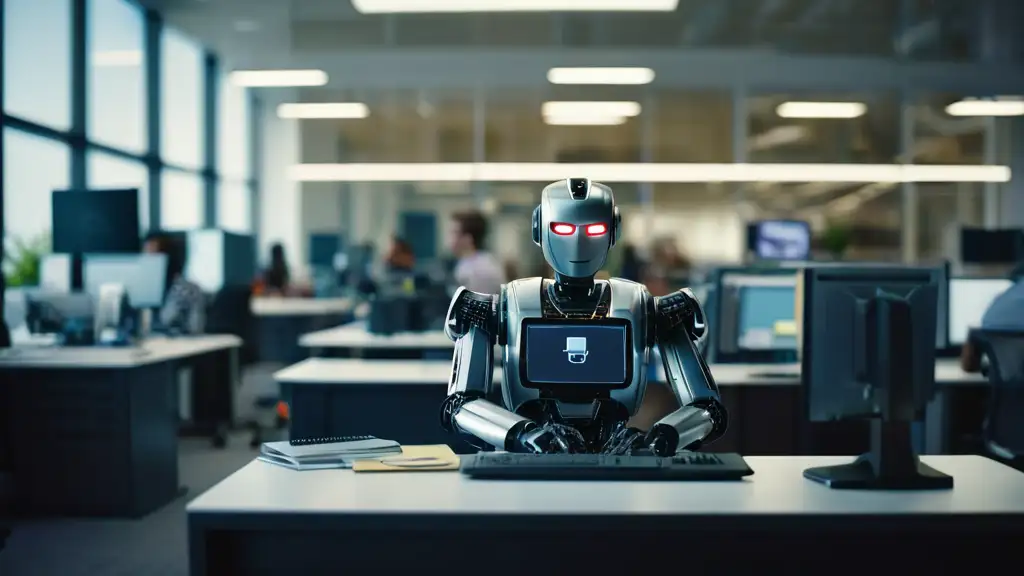

Robotic Process Automation, commonly known as RPA, is a technology that makes use of robots or ‘bots’ to mimic human actions, specifically to handle repetitive and mundane tasks traditionally performed by humans.
RPA is non-invasive in nature and leverages the existing infrastructure without causing disruption to underlying systems. It is used to automate repetitive tasks such as data entry, process standard transactions, or respond to simple customer service queries. It operates in accordance with set business rules and can handle structured data effectively.
The implementation of RPA often involves three key steps: planning, development, and deployment. The planning phase involves identifying and prioritizing the business processes that will be automated. In the development phase, the selected processes are configured to the RPA tool using a defined set of rules and instructions. Lastly, during the deployment stage, the configured bots are tested and migrated to a live environment.
RPA provides numerous benefits, including accuracy, consistency, improved compliance, and cost savings. By eliminating the potential for human error, RPA enhances the accuracy of task completion. Additionally, it can work around the clock, leading to increased productivity. However, it’s also important to understand the limitations of RPA. It lacks cognitive capabilities and cannot handle unstructured data or adapt to changes in the environment independently. It requires well-defined, rule-based processes to operate efficiently.
Understanding RPA is critical to differentiating it from Intelligent Automation, which is an advanced form of automation incorporating elements of Artificial Intelligence to handle more complex tasks.
Intelligent Automation (IA) is a progression from Robotic Process Automation (RPA), characterized by the integration of artificial intelligence and machine learning elements. It is designed to handle complex tasks that require cognitive abilities such as problem-solving, decision making, and understanding natural language.
IA goes beyond the capabilities of RPA, offering not just automation of manual, rule-based and repetitive tasks but also the ability to learn and adapt over time. It can identify patterns, extract context from data, understand it, and make informed decisions based on it.
There are five primary components in IA: Robotic Process Automation, Machine Learning, Natural Language Processing, Cognitive Automation and Intelligent Decisions & Analytics.
Robotic Process Automation is considered the foundation for IA. It handles repetitive tasks that do not require cognitive input. Machine Learning gives systems the ability to learn from data without being explicitly programmed. Natural Language Processing helps systems understand human language in a meaningful way. Cognitive Automation mimics human decision-making processes and responds to changes accordingly. Lastly, Intelligent Decisions & Analytics provide businesses with insights by processing and analyzing large amounts of data quickly and accurately.
The potential of IA lies in its capacity to not only digitize and automate processes but also to optimize them. This optimization can lead to increased efficiency and productivity, reduced errors, and significant cost savings. Moreover, it can free up valuable human resources to focus on more strategic and creatives tasks – those aspects of work that require human judgement, emotional intelligence, and interpersonal interaction.
It’s important to remember that IA is not about replacing humans; it’s about augmenting human capabilities and enabling businesses to deliver superior customer experiences, drive innovation, and achieve competitive advantage in today’s rapidly changing digital landscape.
Robotic Process Automation (RPA) primarily focuses on automating repetitive, rule-based tasks. It excels in executing well-defined, routine processes that require little to no human judgment. On the other hand, Intelligent Automation (IA) expands upon these capabilities by integrating Artificial Intelligence (AI) and Machine Learning (ML). This fusion allows IA to tackle more complex tasks, handle unstructured data, make decisions based on context, and even learn from previous experiences.
RPA is adept at dealing with structured data, where information is organized and easily accessible. However, its capacity to manage and interpret unstructured data, such as emails, images, or social media posts, is limited. IA shines in this aspect as it can comprehend and process such vast amounts of unstructured data due to its inherent ability to emulate human cognition. Its built-in Natural Language Processing (NLP) and Optical Character Recognition (OCR) capabilities further bolster this advantage.
While RPA can scale horizontally, meaning it can replicate the same task across multiple systems simultaneously, it struggles with vertical scalability—adapting to evolving or changing tasks. Conversely, IA demonstrates impressive resilience and adaptability as it can evolve with advancing business needs and varying tasks. IA systems are capable of learning and improving over time, which equips them to respond dynamically to changes and provide more strategic value over the long run.
Robotic Process Automation (RPA) and Intelligent Automation (IA) have opened a new doorway in the realm of small businesses, allowing them to compete with their larger counterparts. These technologies automate repetitive tasks, hence driving operational efficiency. By employing RPA, small businesses can free up their employees’ time, allowing them to focus on strategic goals instead of monotonous chores.
Implementing RPA and IA can result in significant cost savings for small businesses. A common misconception is that these technologies are a reserve for large organizations. However, small businesses stand to benefit enormously from the reduced operational costs associated with automation. Additionally, RPA and IA promote productivity by reducing error rates, thus saving time and resources spent rectifying mistakes.
The world today operates in an increasingly digital landscape. For small businesses to thrive, they must adapt to this changing technological climate. RPA and IA can provide the necessary edge in this respect, enabling small businesses to deliver services more quickly and accurately. This enhanced efficiency can attract more clients, boosting business growth. Furthermore, the ability to operate 24/7 facilitated by automation also provides a competitive advantage in terms of customer satisfaction and service delivery.
Before you can decide between Robotic Process Automation (RPA) and Intelligent Automation (IA), it’s crucial to first understand the specific requirements of your business. While both technologies have their individual strengths, their effectiveness is highly dependent on the type of tasks they are applied to. For instance, if your business involves a large number of repetitive, rule-based tasks, RPA might be the more suitable option. Conversely, if your tasks require complex decision-making processes and greater levels of adaptability, then IA would be better suited.
The nature and complexity of tasks significantly influence the selection between RPA and IA. RPA functions best where there’s consistency and predictability, such as data entry, form filling, and report generation. It’s ideal for automating monotonous tasks that follow a specific set of rules. On the other hand, IA comes into play when the operations involve cognitive abilities, like understanding natural language, recognizing patterns, learning from past actions, making judgments, and improvising solutions.
Another key factor to consider when choosing between RPA and IA is the cost of implementation and operation. While RPA can often be less expensive and quicker to implement due to its rule-based nature, IA can require significant investment in machine learning capabilities and data analysis tools. However, the value derived from the use of intelligent automation may justify its higher initial cost, especially if it leads to improved business performance and competitive advantage over time.
If you would like any guidence on how to move your business forward, GGGlobal has the necessary skillset to help you manage your business more efficiently and more profitably. if you would like some assistance, please dont hesitate to contact us.
From business planning to assisting with your organisations growth, we are happy to advise and help where we can. Get in touch to start your no-obligation consultation!

